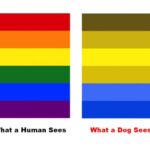How sharp is their vision and are dogs colorblind?
A dog’s vision is quite different from human vision. Dogs see the world in fewer hues than we do, but this doesn’t mean our canine companions are completely colorblind. But even if dogs’ visual worlds are not as clear or as colorful as ours, their ability to see motion is superior.
How do dogs perceive color?
Human Eyes = Three Types of Cones in the Retina
The human eye can see using three kinds of color-detecting cells called cones. By comparing the way each of these cones is stimulated by incoming visible light, our brains distinguish red wavelengths from green wavelengths and blue wavelengths from yellow wavelengths.
Canine Eyes = Two Kinds of Cones in the Retina
Dogs’ eyes, just like those of most other mammals, contain just two kinds of cones. These enable their brains to distinguish blue from yellow, but not red from green. Dogs are not completely colorblind, but their eyes are structured in a similar way to those of people with red-green color blindness, whose eyes also lack the third kind of cone normally present in humans. Scientists describe that we can get an idea of what dogs see, if we assume their brains interpret signals from their cone cells much like the brains of people with colorblindness do.
What dogs vs humans see
Click to enlarge pics and for slide show view
So when yellow light is detected in the cone cells of the retina, but is suppressed when blue light hits the cones. A dog’s brain interprets the excitation or suppression of these neurons as the sensation of yellow or blue, respectively. However, in dogs and in people who are colorblind, both red light and green light have a neutral effect on the neurons. With no signal to interpret these colors, the dogs’ brains don’t perceive any color. Where you see red or green, they see shades of gray.
There is some evidence that dogs may be able to see colors humans cannot. A study published 2014 found that the lenses in the eyes of a dog transmit significant amounts of ultraviolet light, whereas these wavelengths are blocked by human lenses. This suggests that dogs might see more blue light than we do.
Other Differences in Vision
Recent studies have shown that in addition to missing some of the hues that can be perceived by human eyes, dog vision lacks some of the sharpness of human vision.
- The researchers discovered that dogs — or at least the whippets, pugs and the single Shetland sheepdog that participated in the experiments — were very nearsighted. The results of the experiment suggest that dogs, in well-lit conditions, have roughly 20/50 vision. This means that they have to be 20 feet (6 meters) away from something to see it as well as a human who is 50 feet (15 m) away from that same object.
Night Vision and Movement
- Canines make up for this ‘nearsightedness’ with more sensitive night vision and much better detection of movement at night.
-
- While dogs’ night vision is fairly blurry, at roughly 20/250, studies show, it is also much more sensitive than humans’ night vision.
- While human eyes are chock-full of cones, which help detect colors and work best in bright daylight, dogs’ eyes contain more of the light-detecting cells known as rods, which distinguish between dark and light and thus are at their best in low-light conditions, according to the Merck Veterinary Manual.
- There is one area where their vision is much better than ours. They are much better at detecting motion. This is due to something called the critical flicker fusion rate. Imagine a light that flickers faster and faster. By the time the light is flickering 60 times per second, humans will believe the light is shining steadily. For dogs that same light has to flicker roughly 75 times per second to fool a dog. This ability likely enables dogs to spot moving objects, such as prey, much more quickly and accurately than humans can.
Interested in what your dog sees when he/she watches TV? Click [here].



